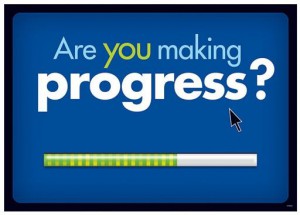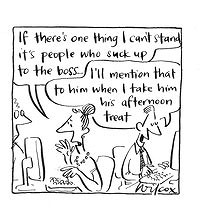I had the fun opportunity to introduce Tim Sanders to our SkillSoft Perspectives conference yesterday morning. Following is what I prepared. What I said in real time yesterday was probably close, but who knows. When presenting, keep your knees bent. And if you’re wondering…Tim killed. So wonderful and spot on message.
Good morning. In just a few moments we will be presenting a live interactive satellite and webcast presentation featuring Tim Sanders and produced right here from the main stage at Perspectives. If you have attended in past years you may recall we have beamed IN live presentations featuring Sir Ken Robinson, Don Tapscott and Tom Peters from distant production studios around the country. This year as a special treat we thought we would bring the event to you and broadcast live from the conference, from right here on the floor of the event.
Today’s live presentation will reach well over 600 organizations and companies around the globe and up to 40,000 individuals – including significant audiences in Europe and groups joining us in the evening in the middle east.
Tim Sanders will spend a few moments with us in advance of today’s event speaking on our specific opportunities and possibilities in the world of talent, human resources and leadership development and the power of lifelong learning. For his main broadcast presentation he will share ideas from his new book Today We Are Rich: Harnessing the Power of Total Confidence. Because by understanding the source of confidence we can preempt personal and organizational recessions and begin to build Cultures of Confidence. We have all seen the engagement data from Gallop, TowersWatts that reveals less than a third of the people in organizations describe themselves as fully engaged. A Culture of Confidence builds an ecosystem of full engagement because it allows people to reach beyond the expected diligence, expertise and compliance and tap into that discretionary effort of initiative, creativity and passion that gives rise to purpose.
Consider the pharmaceutical Genentech who has a stated purpose and a mantra of IN BUSINESS FOR LIFE. Genentech has consistently been voted in the top 10 places to work for, and if you talk to the people there they will tell you the secret sauce is their culture.
In 2003 after clinical trials and FDA approval Genentech introduced the genetically-engineered intravenous drug Xolair to the asthma medication market. Unlike standard asthma treatments that stop asthma attacks after they occur, Xolair was developed to block the histamines in our immune system that trigger attacks. It was preventative and effective short and long term because it would first curb the attacks, and then allow the patient to lead a life without fear of asthma attacks, instead of using drugs that would simply stop them once started.
Genentech released Xolair with confidence because on paper they knew they had the killer app and rolled out their marketing, sales readiness, inventory and distribution in anticipation of strong sales. But strangely after 6 months into the product roll-out sales were well below anyone’s anticipation. Then the financial analysts spotted an anomaly – a big sales spike coming out of Dallas Fort Worth. Out of 242 national sales reps, two women in the Dallas area created a new sales playbook and were selling twenty times the national average.
See Genentech had previously built market expertise in cancer medicines, not asthma drugs. And if you’ve visited an oncology or pulmonary unit as often as I have recently, you’ll know the oncology specialists routinely administer intravenous chemotherapy and other medicines. But Xolair’s market target was allergists, pediatricians, pediatric nurses. Infusions require a different set of protocols not normal in your standard child-doctor visit. Clinicians administering Xolair also must be trained in recognizing rare reactions or side effects. The sales reps could spend all day with powerpoint and graphs talking about the statistical benefit and effectiveness of Xolair and they still wouldn’t get past the client’s apprehension about simply administering it.
The crux of the problem was mindset and methods of the pediatric doctors and nurses. The challenge was to expand their skillset and change the office culture to align with their goal, and remember Genentech’s goal is IN BUSINESS FOR LIFE.
So these two reps in Dallas and their team created a new playbook in which they became consultants and mentors in administering Xolair. They educated the doctors to focus on the long term lifestyle benefits – like their patients could own pets now or pick up jogging again. They taught the clinic staff how to navigate the new insurance paperwork maze to get reimbursed for this new treatment. In short, they stopped applying force and started becoming change artists working in close partnership with their clients. This kind of emotional intelligence, initiative and creativity working in service of a shared purpose is much more readily possible within environments that encourage and reward risk. In Cultures of Confidence.
But in this story let’s not get overly distracted by the process, the mechanism by which these two innovative sales reps worked with their customers. They used onsite tutorials and in-person workshops to educate their customer but they could have used an iPhone app or some other app perfect for the puzzle. In our work to create and cascade real behavioral change we can get wrapped up in the machine, the killer app, when really the mechanism should be transparent and frictionless to the user. The story line is about their mantra: IN BUSINESS FOR LIFE.
Don Tapscott has a marvelous illustration of this when one day a few years ago he was in his house when down the hall he hears his son calling out, “Dad! Dad! Come here – you’ve got to check this out!” So Don walks down the hall to his son’s room and finds him at the computer looking at images of space and his son is saying, “Look Dad, that’s quasar, and that could be a black hole, and over here are stars being born, and this light we’re looking at is millions of years old! Isn’t that amazing!”
Don is pleased with his son’s interest in the cosmos, and says “That’s very cool son, where did you get these images?” And his son says, “Oh, they’re not pictures I’m streaming live from Hubble.” At this point Don’s jaw drops, and he says to his son, “What?! Do you understand you are harnessing the most powerful telescopic instrument on earth? And it’s not even on earth?” To which his son replies, “Yeah whatever Dad, but look that’s the Orion Nebula!”
Ultimately our purpose here together as colleagues at this conference is about connecting people with ideas. Ideas that can change both their beliefs and their behaviors, which then can cascade out and change whole ecosystems within an organization. Providing people with the confidence of ideas and knowledge allows us to reach through our fears, find our passion and display it through purpose. See our passion is what we love to do, but our purpose is why the world loves you. I said, our passion is what we love to do, but our purpose is why the world loves you.
Please help me in welcoming our host for today’s keynote presentation, the witty, fun, intelligent, and always telegenic, SkillSoft’s own Tracey Matisak!
Welcome Tracey. Ladies and gentlemen, I want to recognize for a moment Tracey and our friends at D2 productions. Like the wizard behind the curtain Dave Walzer is somewhere in the vicinity listening on headphones and watching on 16 monitors. At last count, over more than a decade we have produced almost 100 of these events throughout North America and we are deeply honored to share with you such talented professionals that make this all possible. Please join me in thanking them both and everyone here behind the scenes that make this magic possible.





